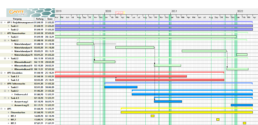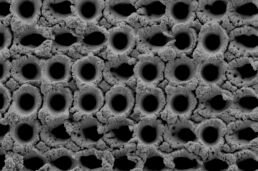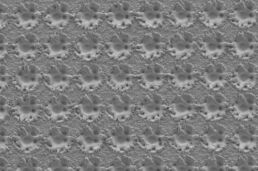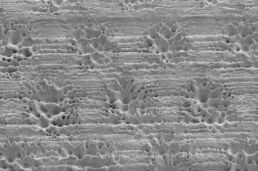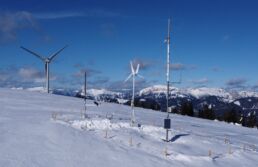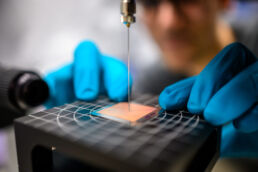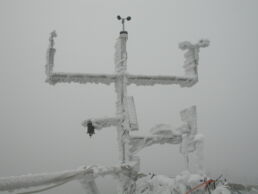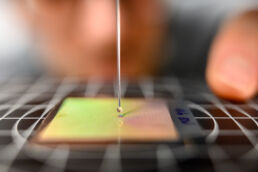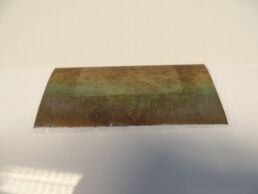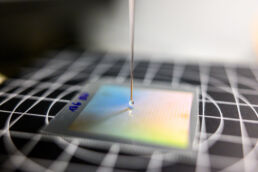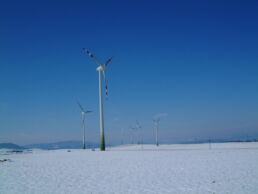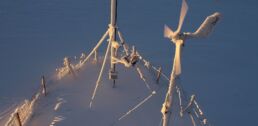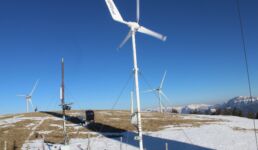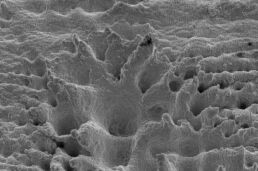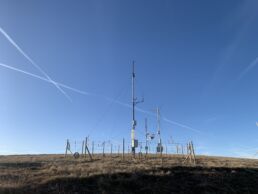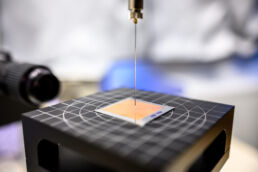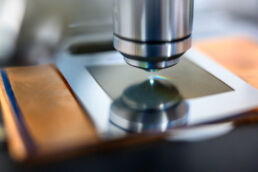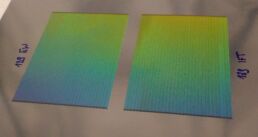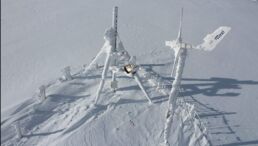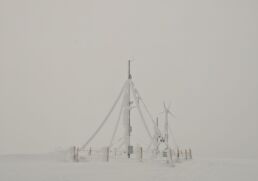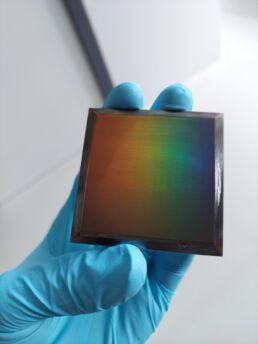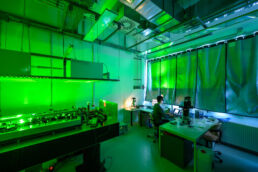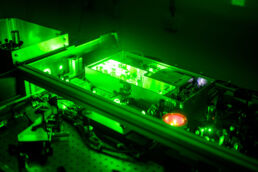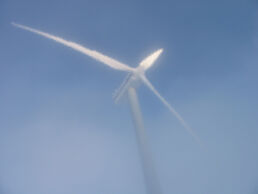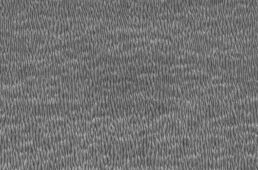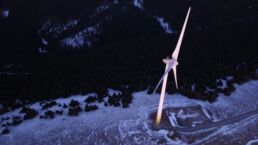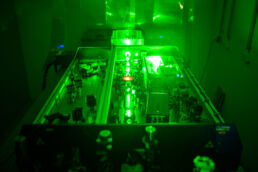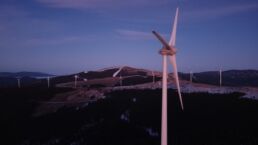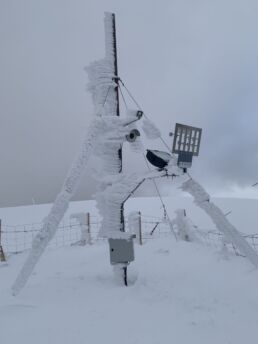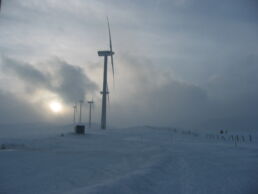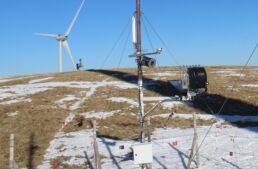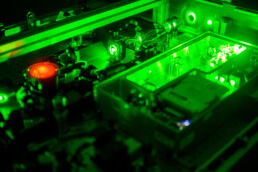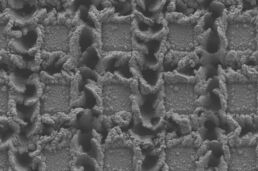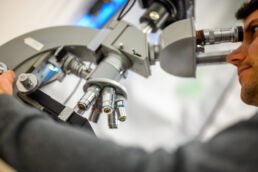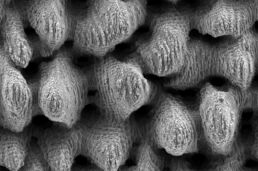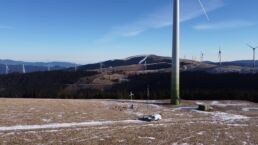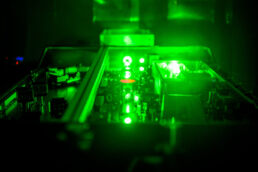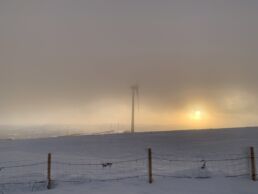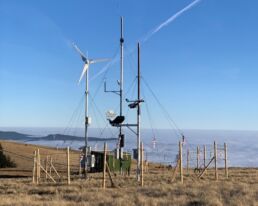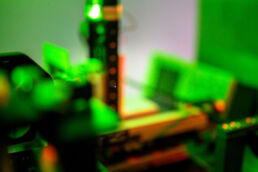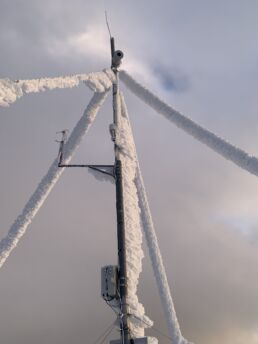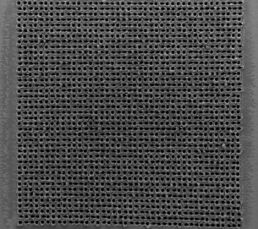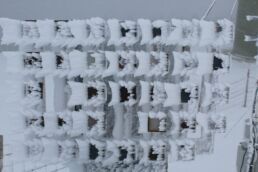Problems are there to be solved
Nanostructuring against ice formation
NICE – Reduction of ice formation by nanostructuring of surfaces with an ultrashort pulse laser.
Funded by the Austrian Climate and Energy Fund within the framework of the Energy Research Program, 5th call 2018.
Project number: 871733
Project duration: April 2019 to March 2023
Many sites with icing conditions have excellent wind conditions and great potential for wind energy use. According to Task 19 of the IEA Wind TCP, wind turbines (WTs) with a total capacity of 137 GW were installed at sites prone to icing in 2020. In Austria, practically all wind turbines installed so far are affected by at least moderate icing conditions. However, icing of wind turbines pose a challenge to safe operation.
The three essential aspects are:
- Danger to persons in the vicinity of a wind turbine due to falling pieces of ice,
- Reduced energy yield due to poorer aerodynamic properties,
- Heavy mechanical loads due to uneven ice distribution (unbalance).
With this in mind, wind turbines are usually shut down as soon as the monitoring systems detect icing on the rotor surfaces. The operational readiness of the system can now be restored either by natural defrosting or by the use of energy-intensive de-icing systems. In practice, warm air heaters in the rotor blade or an electrical resistance heater on the blade surface are used for this purpose. Other deicing methods such as mechanical impulses by means of vibrators, eddy currents, microwaves or chemical deicing are technically hardly feasible on wind turbines. However, preliminary studies show that hydrophobic surfaces can make icing more difficult or reduce icing duration.
The NICE project therefore aims to modify technical surfaces so that they have low adhesion to water, snow and ice and prevent the spontaneous formation of ice by the precipitation of supercooled water droplets. For this purpose, nanostructures in the sub-µm range are generated on technical surface samples with an ultrashort pulse laser (UKPL) and the wetting behavior is analyzed in a first step. This will be accompanied by a simulation model of the wetting behavior of surfaces in the sub-µm range, which should facilitate the search for suitable materials and nanostructures in the future. The icing behavior of the nanostructured samples will be investigated in a climatic wind tunnel at the Vienna University of Technology. Defined conditions (temperature, wind speed, droplet size, etc.) are set in this.
The most promising samples will be exposed to the weather together with comparison samples in different field tests at a wind turbine site with a high risk of icing, and the icing behavior of the sample surfaces will be evaluated qualitatively and quantitatively. After completion of the field tests, the investigation of the nanostructures and their properties in the laboratory will allow conclusions to be drawn about changes and resistance of the nanostructures.
NICE work packages
Work package 1: Project management
- The work package includes the coordinated implementation of the other work packages as well as cost control and reporting.
Work package 2: Laser nanostructuring with the ultrashort pulse laser
- Task 2.1: Building on preliminary work at TU Wien in the field of laser structuring, hydrophobic nanostructures are created on different substrate materials. In these processes, the interactions between the laser and the material directly at the surface and in the underlying boundary layers are studied to improve the process parameters and the resulting nanostructures.
- Task 2.2: The nanostructured samples are analyzed systematically. Among other things, their hydrophobic properties are investigated and characterized. Further focal points are the investigation of the interaction of the laser processing with the different materials and a possible optimization of the structures with respect to hydrophobic properties or ice adhesion.
- Task 2.3: Sample behavior under icing conditions will be tested at laboratory scale in a climatic wind tunnel with selected sample materials and nanostructures. This will determine the extent to which there is a relationship between the hydrophobic properties of the surfaces and ice growth.
Work package 3: Simulation of the wetting behavior of samples
- Task 3.1: existing models for wetting of surfaces by droplets will be extended to a simulation model for the sub-μm range as samples are prepared.
- Task 3.2: The simulation model from Task 3.1 will be adapted to use it for designing hydrophobic surfaces with specific properties. In this way, the manufacturing processes of laser-structured surfaces for a wide range of applications are to be improved.
Work package 4: Field tests with nanostructured samples
- Task 4.1: Surface samples will be exposed to the elements in a multi-year field test on a permanently installed fixture in an exposed location. A camera documents the icing and defrosting processes with high-resolution images, while a capacitive ice sensor measures the icing intensity. In addition, meteorological data such as temperature, humidity or wind direction are recorded.
- Task 4.2: The behavior of the surface structures under practical conditions was investigated by application to the rotor blades of a small wind turbine. The sample condition was recorded by another high-resolution camera. Another focus was on studying the resistance of nanostructures.
- Task 4.3: Based on the camera images, the degree of icing of the individual samples is evaluated qualitatively and quantitatively and the icing duration is determined. In addition, the icing and defrosting processes are compared with the measured data for temperature, humidity and wind and evaluated in detail.
Work package 5: Dissemination of project results
- The results of the project will be made available to the public and presented to an international audience of experts. In line with the research topic, the results are of importance on the one hand for the field of laser processing and manufacturing technology and on the other hand, of course, especially for the wind energy sector. The dissemination of results therefore takes place in a targeted manner via contributions to specialist meetings and conferences (e.g. AWES, Winterwind) and publications in specialist media. Furthermore, the results are made available to an international research community through the cooperation with the IEA Wind Task 19 Wind Energy.
Murzin, S. P., Balyakin, V. B., Liedl, G., Melnikov, A. A., & Fürbacher, R. (2020). Improving Tribological Properties of Stainless Steel Surfaces by Femtosecond Laser Irradiation. Coatings, 10, 606. doi:10.3390/coatings10070606
Abstract: A possibility of improving tribological properties by femtosecond laser irradiation on an example of a steel surface by creating regularly arranged micro-grooved textures that contain self-organized microstructures and nano laser-induced periodic surface structures (LIPSS) was determined. The friction coefficient of the treated surface of a sample of cold-rolled 1.4301 stainless steel was evaluated using a CSM Instruments SA tribometer according to a pin-on-disk test scheme at a specific pressure of 1 MPa. It was found that the coefficient of friction was reduced by 35% compared to the initial grinded surface. Such laser treatment can find application for using parts in conditions of dry or boundary friction, mainly in units in which the use of lubricant is unacceptable or extremely undesirable.
Fuerbacher, R., Liedl, G., & Murzin, S. P. (2021). Experimental study of spatial frequency transition of laser induced periodic surface structures. Journal of Physics: Conference Series, 1745, 012017. doi:10.1088/1742-6596/1745/1/012017
Abstract: This study shows the influence of laser fluence and pulse number on the spatial frequency distribution of laser induced periodic surface structures (LIPSS) on a stainless steel surface. Also the transition of LIPSS to larger self-organized, periodic, cone-like structures has been investigated. The experiments were carried out using a Ti:Sapphire femtosecond laser system with 800 nm center wavelength, a pulse duration of 30 fs and a repetition rate of 1 kHz. Experiments have been carried out on flat, cold-rolled stainless steel surfaces (1.4301) by variation of the laser output power and feed rate. It could be shown that the transition of low spatial frequency LIPSS (LSFL) to high spatial frequency LIPSS (HSFL) is a continuous process, strongly depending on the laser single pulse fluence and the pulse number. At higher accumulated fluences the transition of LIPSS to larger self-organized structures could be observed. As a result, hierarchical structures were created with micrometer-sized cones at the bottom and nanometer-sized LIPSS on top. By further increasing the accumulated fluence, the grooves between the micro structures are widend until the ablation threshold of the alloy is reached. These hierarchical structures could be of considerable value in improving wetting properties of technical surfaces.
Fürbacher, R., & Liedl, G. (2021). Investigations on the wetting and deicing behavior of laser treated hydrophobic steel surfaces. In U. Klotzbach, R. Kling, & A. Watanabe (Eds.), Laser-based Micro- and Nanoprocessing XV (p. 39). SPIE. doi:10.1117/12.2578138
Abstract: Biomimetic technical surfaces are very interesting for a wide field of possible applications in material science and engineering. For example, changing the wetting and deicing properties of components used in cold environmental conditions can help to reduce ice or snow aggregation, and thereby improve functionality and operational stability. In this study we investigate the correlation between wetting and deicing behavior of micro- and nanostructured stainless steel samples (1.4301). The samples were modified using a Ti:Sapphire femtosecond laser system with 800 nm central wavelength, a pulse duration of 30 fs and a repetition rate of 1 kHz. We generated two fundamentally different types of hydrophobic and superhydrophobic structures by varying the laser fluence and the number of applied pulses, thereby creating hierarchical structures in the micrometer regime and laser induced periodic surface structures (LIPSS) in the nanometer regime. The static water contact angle has been measured to quantify wetting properties of laser treated samples. To determine the ice adhesion shear stresses at the ice/steel interface, cuvette encased ice columns were frozen onto the structured samples and sheared off by a push rod, while recording the forces. Several icing/deicing cycles have been carried out to investigate a possible decline in wetting behavior due to wear or other mechanisms. We could show that surfaces with hierarchical microstructures and superhydrophobic wetting behavior will lose its ability to repel the applied water while freezing. Larger structures with higher surface roughness lead to increased ice adhesion shear stresses compared to the initial unstructured surface. LIPSS on the other hand might not be as hydrophobic, but showed lower ice adhesion in the range of the reference sample.
Fürbacher, R., Liedl, G., Otto, A. (2022). Fast transition from hydrophilic to superhydrophobic, icephobic properties of stainless steel samples after femtosecond laser processing and exposure to hydrocarbons. Pocedia CIRP.
Abstract: Femtosecond laser processing is a key technology for surface modification and can be used to trigger superhydrophobic behavior through a combination of topographical and chemical effects. Nevertheless, immediately after laser processing, steel samples appear superhydrophilic and evolve into a hydrophobic state over a period of several days to weeks. To reduce the wetting transformation time down to hours, the sample can be stored in a vacuum chamber. In the chamber, the absence of atmosphere and thereby water vapor leads to an increased adsorption of hydrocarbons by the surface. In this study, we investigate an alternative and less demanding approach for shortening the wetting transformation time significantly by exposing the laser treated samples to a hydrocarbon liquid/atmosphere. This not only leads to a faster transformation, but also to an improved deicing performance. Both effects are analyzed for various hydrocarbon liquids and different laser patterns with respect to the surface chemistry.
Rittinghaus, C., Höher, M., Fürbacher, R. (2023). NICE – Reduction of ice formation by nanostructuring of surfaces with an ultrashort pulse laser. Conference paper and presentation Winterwind 2023, Åre.
Webpage Winterwind:
https://winterwind.se/program/abstracts/


